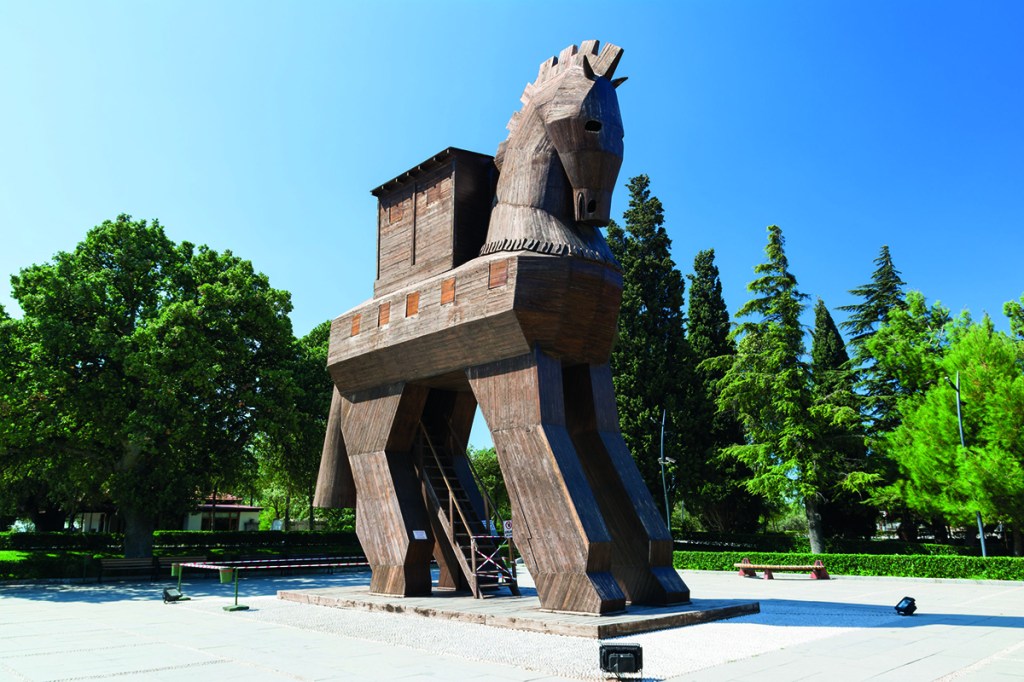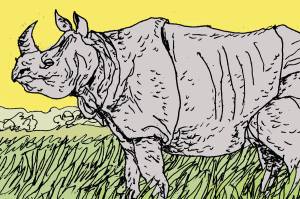A wooden horse, a fallen hero and Helen, the most beautiful woman in the world. These three things transformed a hillock in Asia Minor into a legendary city. Few places can conjure up such stories of love and loss, homesickness and heroism, gallantry and grief as Troy.
Over 3,000 years after Homer wrote in The Iliad of the 10-year siege of King Priam’s mighty citadel, I’m standing on an unremarkable patch of scrubland in northwestern Turkey. This unpromising site claims to be the real Troy — the very spot where Zeus’s daughter Helen fled to make love to Paris; where the mighty Hector, the Trojan general, fell at the hands of Greek warrior Achilles; and where the giant Trojan Horse entered the city concealing Greek warriors in its wooden belly.
Homer’s epic poem, one of the oldest works of western literature, has attracted tourists to this unassuming spot for millennia. Julius Caesar, Alexander the Great and the Emperor Constantine were all here before me, footstepping Hector and hoping to tread where Helen wept. The Unesco World Heritage site is still being excavated to add, if not ancient bones then at least shards of pottery, to the archaeological evidence and make the myth real.
We know Troy doesn’t stand exactly where it did when Homer was writing. Since those ancient times, the city has crept four miles inland from the Aegean shore and overlooks the Dardanelles (now Canakkale) Straits. I’d taken a short ferry ride and made a five-hour drive from Istanbul, through fields of sunflower husks and twisted olive trees, to Priam’s battleground. I was met by Professor Rustem Aslan, excavation director at Troy, who had begun digging here on Hissarlik Hill as a student in the 1980s and hasn’t put his trowel down since. He points to the 10 layers that are being unearthed, each representing a different city before it was abandoned or destroyed by war, fire or earthquake, each built upon the ruins of its fallen predecessor. The Troy of Hector, Helen and Priam is just one of these.
The site may be historically and culturally significant, but it’s not spectacular. Beyond the entrance are crumbling rows of soft mud bricks and limestone blocks making walls, moats, ramps and the remains of a small Roman theater.
‘Tourists are disappointed,’ says Aslan sadly. So they’ve tried to liven up the visitor experience. At the entrance, legend-seeking visitors can climb inside the belly of a giant wooden horse, as if they were Greek combatants about to secretly storm the citadel and vanquish Troy. Some have their picture taken dressed up in the robes and brandishing the blades of fallen heroes. Professor Aslan looks on, welcoming the invaders but cautious of what memories they’re taking back home with them. ‘The two main elements that resonate about Troy are Helen and the Wooden Horse. Well, these are the two which we have no evidence for at all,’ he says.
Since Homer wrote his epic, the veracity of his story and exact location of the battles between the Trojans and the Greeks has been disputed. Although my cellphone confidently notified me I was in ‘Ancient Troy’, even Aslan admits where we are standing might not actually be as the GPS claims. ‘We can never be 100 percent certain that this is Troy, although we can be enough,’ he says with stoic resignation. ‘Everybody knows that in every legend there is a piece of truth.’
The passionate quest for the Iliad’s true battlefields has led to hasty claims. The affluent German merchant and Homer fan Heinrich Schliemann, who rediscovered the present site in the 1870s, thought he’d found King Priam’s buried treasure, proving the hillock was Homer’s. He was so sure of his discovery that he dressed his Greek wife in the finds and had photographs taken of her draped in the golden finery, as if he were a new conqueror. But the treasures turned out to be over a thousand years too old to belong to the king. Some of them are housed in the site’s museum — a large modern cube — opened in 2018. Alongside the axes, bracelets, weapons, perfume bottles, terracotta pots and ‘tear catchers’ is yet another model of a giant wooden horse.
Schliemann also managed, in his overenthusiastic excavations, to damage with dynamite many of the layers on the site, making identification even more difficult. He smuggled most of the artifacts he found abroad, scattering the evidence. It’s left to the site’s geography, rather than the modest archaeological finds, to provide the most convincing clues to the true Troy.
A northeast wind blows across the site — the same wind that brought in the fabled thousand ships. The farmed plains of Kara Menderes (the ancient Scamander) roll on to the west; southeast are the peaks of the Kaz Daglan, southwest the Aegean coast. It’s a vast blanket of a landscape which closely resembles Homer’s description, interesting for what it evokes more than for any natural beauty.
‘The poet must have observed with great keenness,’ says Aslan. ‘The islands, the mountains, and even the rivers could be identified easily.’ As I wandered around with the Iliad as a guidebook, I couldn’t help but imagine the meddling gods — warmongering Zeus, Achilles’ sea nymph mother Thetis, and Apollo who’s said to have built the walls himself — looking down on me, determining my fate. It’s this spirit, according to Aslan, that’s important. ‘Everyone has their own Troy in their imagination,’ he says.
I left legend behind and took the short ferry ride across the strait to the small town of Eceabat (where another giant wooden horse sits on the quayside) and lodged at the splendid Hotel Caeli, feasting on goat. The Caeli is half-art gallery, half-hotel; the owner built it with the prime purpose of displaying his large collection of contemporary art. He also created a fine vineyard in the hope of changing the tarnished image of Turkish wine from a cheap drink to help wash down a kebab to a fine white to sip with haute cuisine. But the Turkey of President Erdogan has toughened the anti-alcohol laws, so tastings are no longer allowed at the property, though you can still buy a bottle of Porta Caeli with your meal.
The serene hotel sits among the region’s rolling fields, where there’s been warring for centuries. Just up the coast at Gallipoli, the sea laps a small crescent of a pebbled beach faced by high, soft-red cliffs. I found the spent, bent copper casing of a World War One bullet while paddling in the shallow waters, a reminder of the battle of 1915-16 in which over 300,000 lives were lost when French, Russian and British Empire forces tried to capture the Turkish Straits and control the route to Istanbul. The Battle of Gallipoli Museum, a mighty modern citadel of architectural concrete, has become a place of pilgrimage for nationalist Turks. Here the Turkish 57th Regiment — who all died — are described as martyrs. Their three-story, white stone regimental memorial shines close to where they fell, one of many such monuments to mass slaughter along this peninsula. These were the Myrmidons of the Iliad — battle fodder. Their story could have been part of the legend of Troy.
Aslan sees echoes rippling all the way from ancient Troy to modern times. In World War One, Turkish soldiers camped out in Troy, making use of its height over the planes below. The Dardanelles campaigns, he says, ‘have marked the modern political history of Turkey and paved the way for literature, folk songs and films. The Trojan War can be interpreted as a war waged by the West against the East. It is not difficult for commanders or statesmen to find people or events to draw inspiration from this legend.’ The Gallipoli Museum likens the Ottoman soldiers of World War One to Hector’s troops and calls the Gallipoli campaign ‘the last Trojan War’.
The legend of Troy controversially lives on in Turkey, even if the Iliad’s account of it remains unproven. ‘It’s not right to resort to legends to fill out the gaps in our archaeological knowledge,’ says Professor Aslan, whose book Troy: City of Mythology and Archaeology attempts to draw a sharp distinction between what we know and what we may imagine. But only the gods can really be sure if Hissarlik Hill was Homer’s Troy.
This article was originally published in The Spectator’s October 2021 World edition.


















